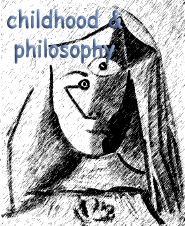possible connections between the montessori method and philosophy for children
DOI:
https://doi.org/10.12957/childphilo.2020.46784Keywords:
montessori, lipman, right to think, creative environment, new teacherAbstract
This paper aims to focus on certain aspects of two education methods: one initiated in the first half of the twentieth century by Maria Montessori, and the other in the second half of that century by Matthew Lipman. The aim – neither comparative nor analytical – is to shed light on the connections and, more specifically, the elements of the Montessori Method that reflect on Lipman’s proposal. The question this paper aims to answer is: can P4C find fertile ground in schools applying the Montessori Method? The paper will focus, among other elements: on the importance to give space to thinking experience from childhood and on the recognition of the value of childhood. Both Lipman and Montessori have systematically observed children of different ages – the former in the first half, the latter in the second half of the twentieth century. Both characterized, gave value, and focused their scientific contributions on children’s ability to think and express their thoughts through languages (purposely in the plural form). As educational researchers and professionals know, children have the ability to think, but such ability has not always been (still isn’t) considered to exist. Even when it is evoked in words, educational choices and proposals seem – still today – to express mistrust towards children’s thought. The two mentioned authors have repeatedly highlighted the importance of an essential right: the right to think and to be given a space – even as children – to exercise thinking with others. In particular, both authors – though envisaging different educational paths – identified the same categories functional to exercising thinking. Their interconnection may guide the actions of teachers, educators, and learning process experts. In fact, P4C might play a role in educational contexts in which the class is already considered a community of inquiry, in which the teacher is assigned the same role as a facilitator
Downloads
References
Contini, Mariagrazia, Demozzi, Silvia, Fabbri, Maurizio, & Tolomelli, Alessandro. (2014), Deontologia pedagogica. Riflessività e pratiche di resistenza. Milan: Franco Angeli.
Dewey, John (1916). Democracy and Education. An Introduction to the Philosophy of Education. London: Macmillan.
Gregory Maughn Rollins, Laverty Megan Jane (2018). In community of inquiry with Ann Margaret Sharp. London: Childhood, philosophy and education, Routledge.
Gregory, Maughn Rollins (2004). “Practicing democracy: Social intelligence and philosophical practice”. International Journal of Applied Philosophy, 18(2), 163-176.
Kohan, Walter (2015). Childhood, education, and philosophy : new ideas for an old relationship. London New York: Routledge
Kohan, W. O., Santi, M., & Wozniak, J. T. (2016). Between ignorance, invention and improvisation. The Routledge International Handbook of Philosophy for Children, 253.
Maughn Rollins, Gregory (2007). “Normative dialogue types in philosophy for children”. Gifted Education International, 22(2-3), 160-171.
Maughn Rollins, Gregory (2011). “Philosophy for Children and its Critics: A Mendham Dialogue”. Journal of Philosophy of Education, Vol. 45 (2): 199-219.
Kennedy, David (2004). “The role of a facilitator in a community of philosophical inquiry”. Metaphilosophy, 35(5), 744-765.
Lipman, Matthew. Thinking in education. New York: Cambridge University Press, 1991.
Lipman, Matthew (1995). “Moral Education higher-order Thinking and Philosophy for Children”. Amsterdam: Early Child Development and Care, vol. 107, pgs.61-70, Overseas Publishers Association.
Lipman, Matthew (2008). A Life Teaching Thinking. New York: IAPC, Montclair.
Lorenzoni F. (2014), I bambini pensano grande. Cronaca di una avventura pedagogica (The children think big. Chronicle of a pedagogical adventure), Palermo: Sellerio Ed.
Montessori, M. (1964) The Montessori method. New York, Schocken Books, Inc.
Montessori, M. (1967). The discovery of the child. New York, Fides Publisher Inc.
Montessori, Maria (2016). Dall’infanzia all’adolescenza (From Childhood to Adolescence). Rome: Franco Angeli.
Morin E. (2000), La testa ben fatta, Riforma dell’insegnamento e riforma del pensiero nel tempo della globalizzazione (The head well made, Reform of teaching and reform of thought in the time of globalization), Raffaello Cortina, Milano.
Rilke R. M. (1989), Lettere a un giovane poeta (Letters to a young poet), Adelphi, Milano.
Sharp, Ann Margaret. “The community of inquiry: Education for democracy”. Thinking in education, The journal of philosophy for children, 9(2), 31-37, 1991.
Sharp, Anne Margaret. “What is a ‘Community of Inquiry'?”. Journal of Moral Education, 16(1): 37-45, 1987.
UNESCO (2007), La Philosophie, une École de la Liberté. Enseignement de la philosophie et apprentissage du philosopher: État des lieux et regards pour l’avenir, UNESCO, Paris.




